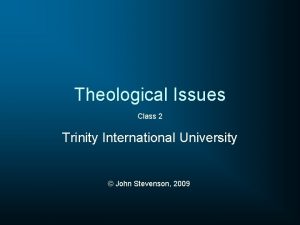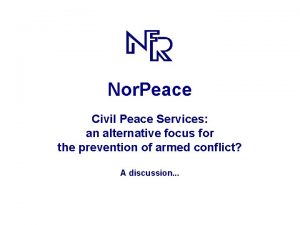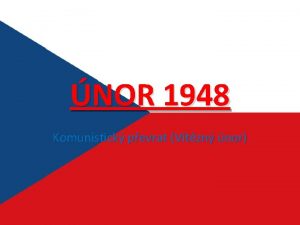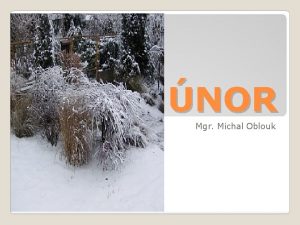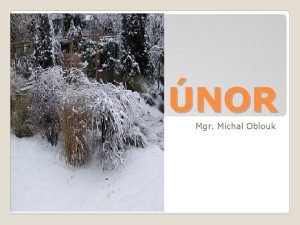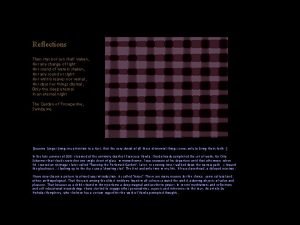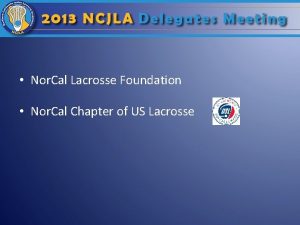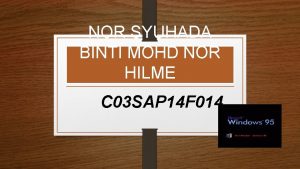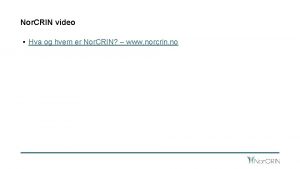Nor Peace Civil Peace Services an alternative focus















- Slides: 15

Nor. Peace Civil Peace Services: an alternative focus for the prevention of armed conflict? A discussion. . .

Definitions • Conflict prevention: is used consistently in this context in stead of the heavier but morre accurate expression: ”prevention of violent conflict”. • Civil Peace Services (CPS): are those activities that are aimed specifically at promoting non-violent solutions of conflicts, human rights and a long term culture for peace. The concept does not cover such humanitarian projects as the building of infrastructures, health and education, even though these can in themselves promote peace. Neither are state agents such as police, juridical entities etc. covered by the concept. Examples of CPS are accompaniment, human rights monitoring, witnessing, training in nonviolent methods, dialogue and conflict management, grassroots mediation, interpositioning, etc.

Many skills must be developed to nourish peacework. Specialised competence is needed to support all the measures that make a holistic input for peace. A great deal and diversity of knowledge is needed to develop the best strategies. We must acknowledge the complexity without becoming disenchanted by it.

Some convincing examples • Nonviolent Peaceforce in Sri Lanka, • Peace Brigades International in Colombia • Save the Children’s clubs in Nepal and Sri Lanka • Nansen Dialogue Centres in the Balkans • Nor. Peace school mediation project in Palestine. • Quaker Services CAPP projects in Rwanda, Burundi and Congo

The questions we need to ask: • What would be the result of a large focused investment in CPS? • Can CPS activities be an alternative to military action to a greater degree? • Can CPS activities, applied in time, avert the need for military action? • What is needed to change the pattern of behaviour from military action to proactive prevention?

The situation in Norway 1: Lots of good stuff! • Many good measures • Good contact between the authorities and the NGO’s (relatively speaking!) • Good on ”Rule of Law”, administrative assistance, traditional development aid, catastrophe aid and human rights. • Good at obtaining personnell for UN/OSCE operations. • Generally speaking, good at peacebuilding in post-conflict situations • Humanitarian aid organisations are aware of conflict sensitivity. The Norwegian tool box for peacebuilding is generous and reasonably comprehensive, but lacks certain important elements in the field of CPS before Norway can be the pioneering country within peacebuilding that it’s politicians like to claim. Little attention is paid to activities involving people-to-people transfer of skills within nonviolence, dialogue, conflict analysis, mediation and conflict management and transformation, and support for the building of networks that focus on these activities.

The situation in Norway 2: Things to improve: 1. More focus on avoiding the crisis in the first place. 2. More research into conflict prevention, with special focus on civilian measures. 3. Use of CPS to a much greater extent. 4. More focus in competence and capacity building within CPS.

1. More focus on avoiding the crisis in the first place ”If we were to genuinely focus on the preventive end of the scale, the need for civilian personnel would increase dramatically. In order to make possible a sufficient number of actors with the knowledge, the skills and the experience necessary to carry out effective prevention of violent conflict, we must think in a completely new direction. ” Tim Wallis, Peaceworkers UK/International Alert

Separate the concepts for ”pre-, during and post-conflict”. Transforming the conflict is about meeting the competing interests of the protagonists in ways that minimise the risk for violence. But often measures aimed at preventing or reducing violence in an accute situation will be necessary in order to avert a decline in the situation that will make conflict transformation impossible. In some situations it would be helpful to uncouple the twin concepts of conflict prevention and peacebuilding from each other in order to ensure the necessary focus on prevention, and thereby to develop the necessary competence and capacity. These two concepts contain many common elements, but the focus on the different elements, and thereby which capacities are demanded will vary.

2. More research into conflict prevention, with special focus on civilian measures • What are the limitations for violence reduction methods such as interpositioning, accompaniment, international presence etc. • Can these activities replace military peacekeeping troops in certain situations? If so, under what circumstances? • In what quantity must we employ CPS measures if they are to have a chance of success? • What else can civilians do to hinder escalation and give a breathing space in the vulnerable period where a conflict is heating up? • Given that CPS, coupled in early enough and in sufficient quantity, can give a breathing space, how do we utilise this space to mobilise the people of a country for peace? • Peace measures that involve the mobilisation of the population must happen on their terms. How do we identify the organisations and key people that will be effective, credible and legitimate partners in the process?

3. Use of CPS to a much greater extent. CPS is not a routine part of the planning when Norwegian Authorities make their strategies for conflict prevention and peacebuilding. They have not recognised the enormous potential that lies behind these, partly because of a lack of research, but also because of a lack of a forum or centre that can spread information, market ideas and build competence. Lack of core funding for small specialised organisations is a problem. The sheer numbers of trained civilians that would be needed to execute an effective operation may appear discouraging (800 civil escorts in Nicaragua in 1981), but not if compared with the numbers of military troops!

4. More focus in competence and capacity building within CPS Peace Competence consists of attitudes, skills, experience and knowledge We must ensure: • better utilisation of the rich competence existing on the Norwegian grass root level in training field workers. (Mediation Council, school mediation, night ravens etc. ) • Better utilisation of young people with academic education within peace related subjects. • Good basic education in peace related skills. • Training on several levels, from generalist and new beginner to advanced specialist. • Reliable methods of evaluating a candidates level (finding the balance between knowledge, skills and experience) • Better utilisation of people with related but not directly relevant experience. • Good routines for preparing field workers

How are these problems met in other countries? 1. How to use the resources created through University education? (see eg. 3. 1, “From academic to operative Field Worker”) 2. How to evaluate peace competence and ensure that we meet the training needs of the individual? (see eg. 3. 2 Peaceworkers UK graded module based system) 3. How to train peaceworkers that have a good overview of the complexity in peacework? (see eg. 3. 3 Forum CPS 4 months course)

Nor. Peace main recommendations are therefore: 1) That Norway to a much greater degree supports research directed at civilian input in the prevention of armed conflict. 2) That an evaluation is made of the potential of establishing a centre for CPS, with • focus on training, knowledge and competence in conflict analysis, conflict transformations, mediation, dialogue, nonviolence, and crisis pedagogic. • an offer of training in the skills that are needed in field work, such as reporting, making priorities, economic management at grass root level, etc. • the possibility of granting core funding to small and specialised organisations that deliver peace services.

It is interesting to ask the question: what if all men and women in Norway were to choose between military service or CPS training. How would that influence our society and our role in the world?
 Neither snow nor rain nor heat nor gloom of night
Neither snow nor rain nor heat nor gloom of night Nor death nor principalities
Nor death nor principalities Nor death nor principalities
Nor death nor principalities Nor death nor principalities
Nor death nor principalities My goal is god himself not joy nor peace lyrics
My goal is god himself not joy nor peace lyrics Language
Language Cost focus and differentiation focus
Cost focus and differentiation focus Business level strategy differentiation
Business level strategy differentiation Actor focus vs object focus
Actor focus vs object focus Civil rights and civil liberties webquest
Civil rights and civil liberties webquest Basic focus strategies for services
Basic focus strategies for services Example of unfocused strategy
Example of unfocused strategy Difference between intserv and diffserv
Difference between intserv and diffserv Wake county human services community services center
Wake county human services community services center Shakespeare education school
Shakespeare education school There is no jew or greek
There is no jew or greek


